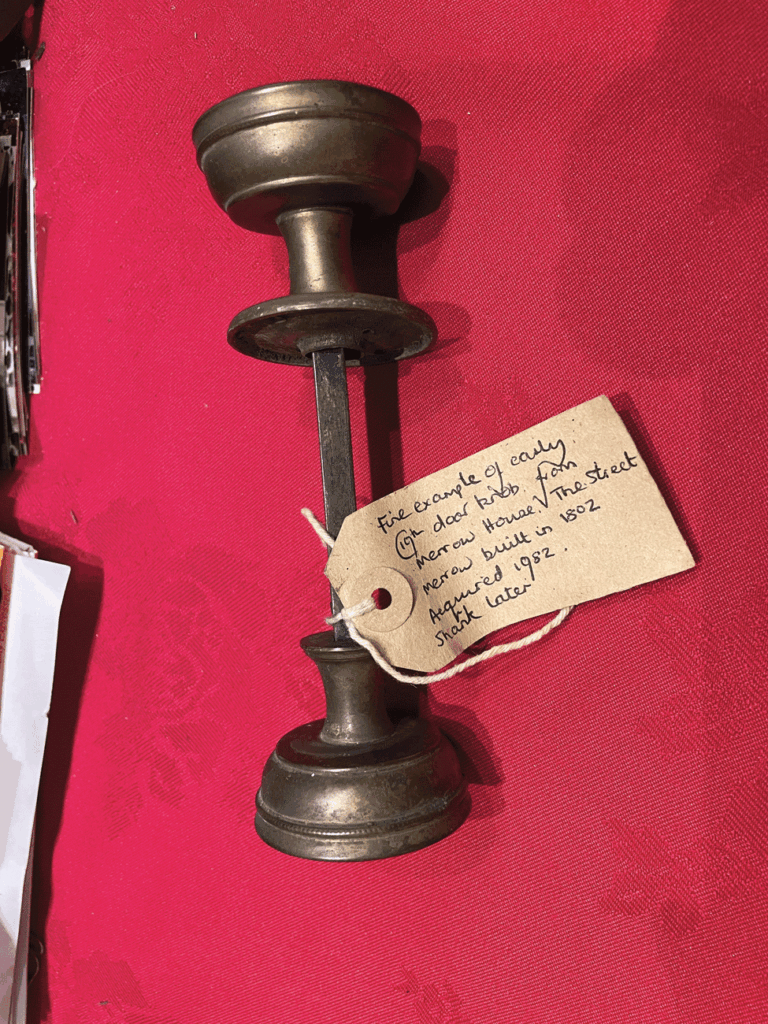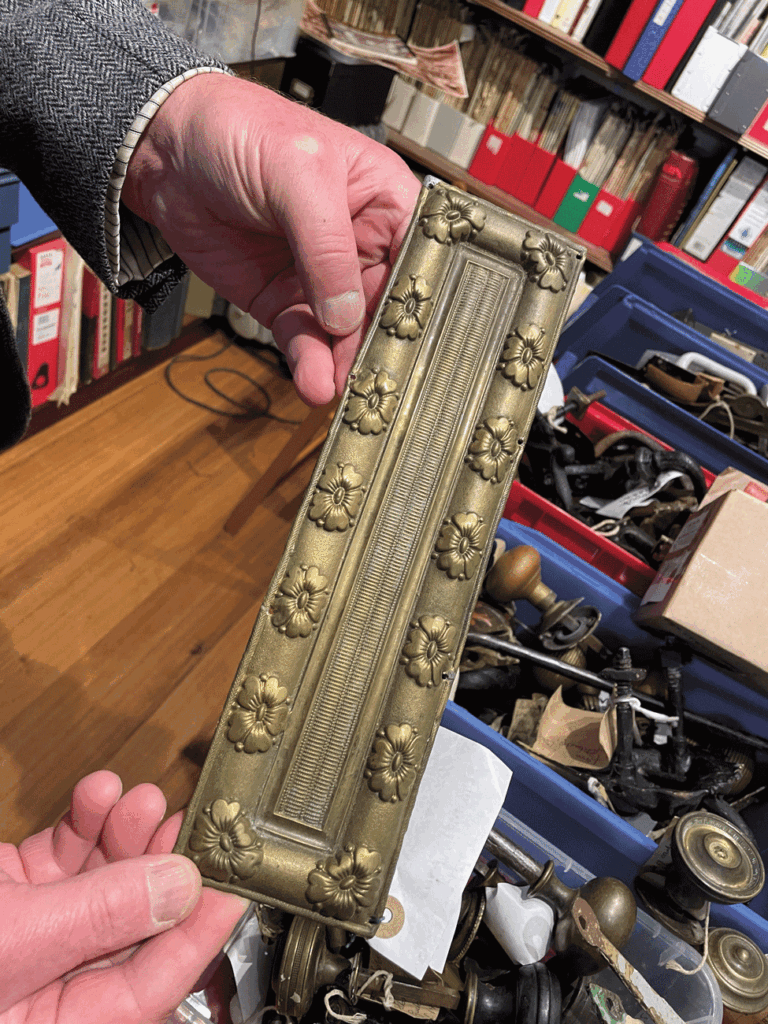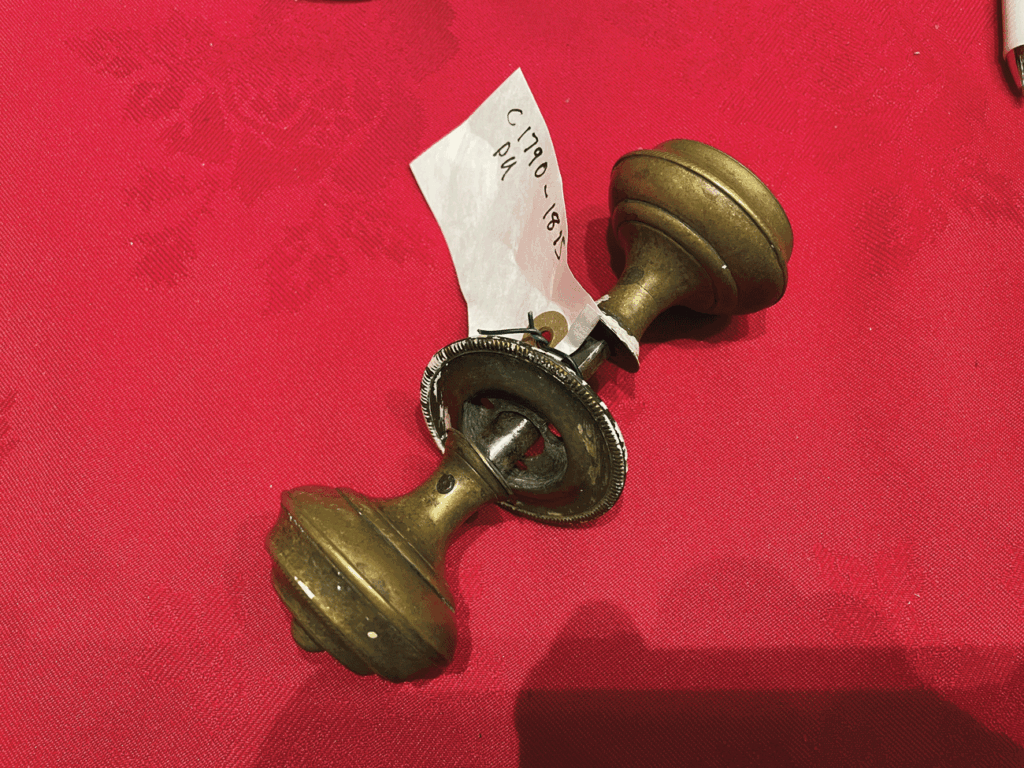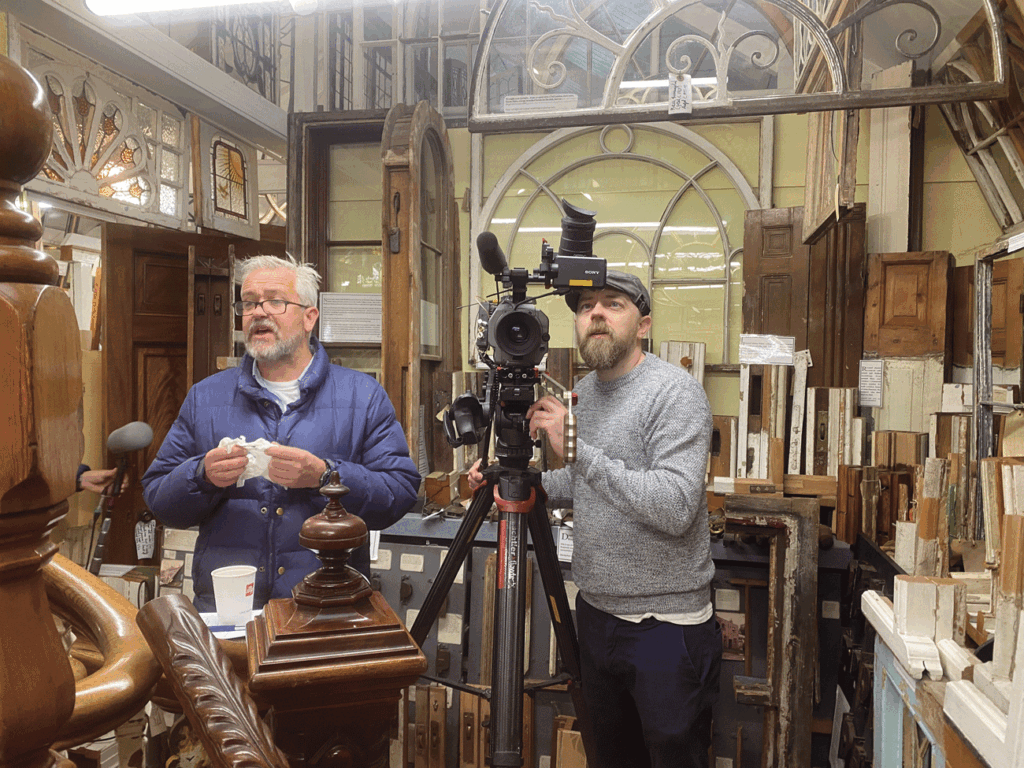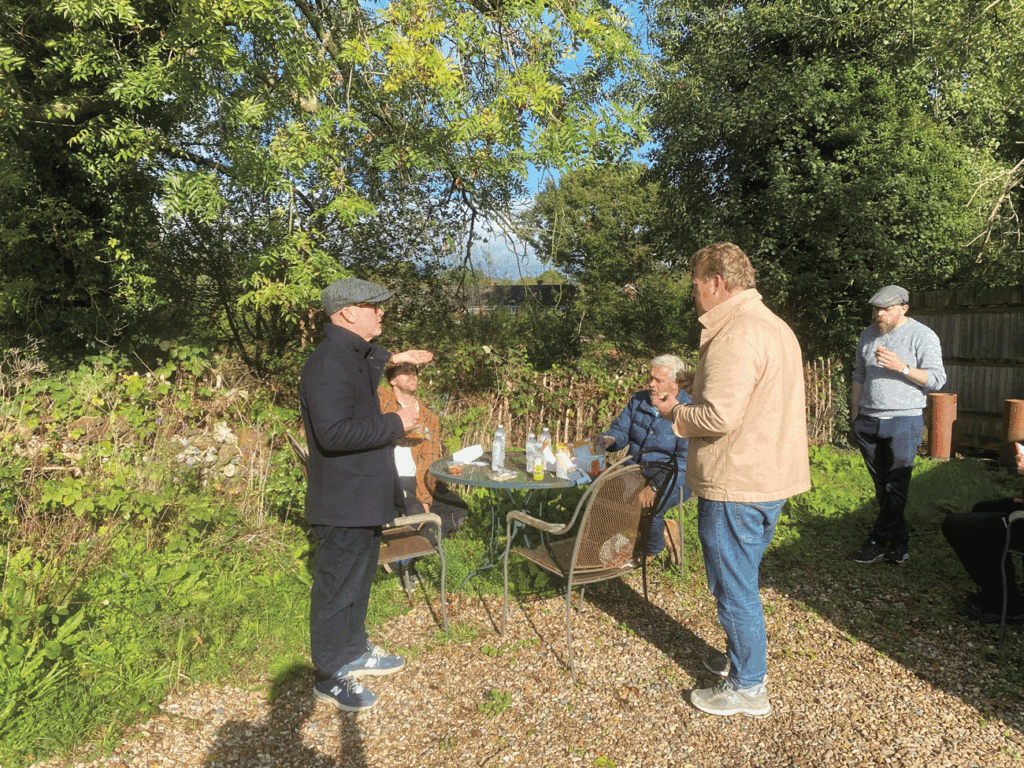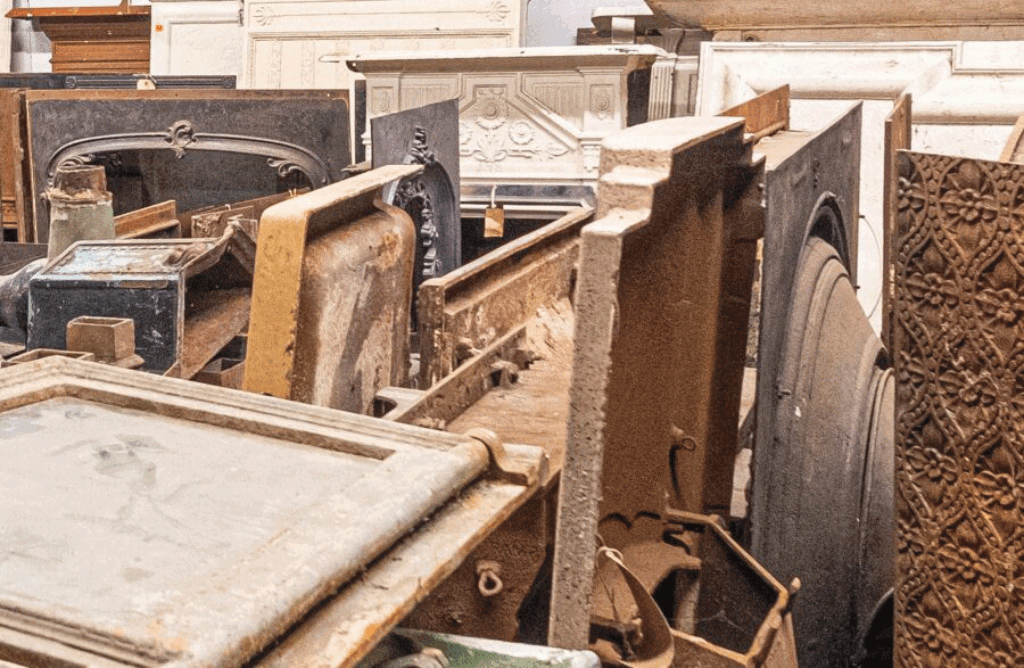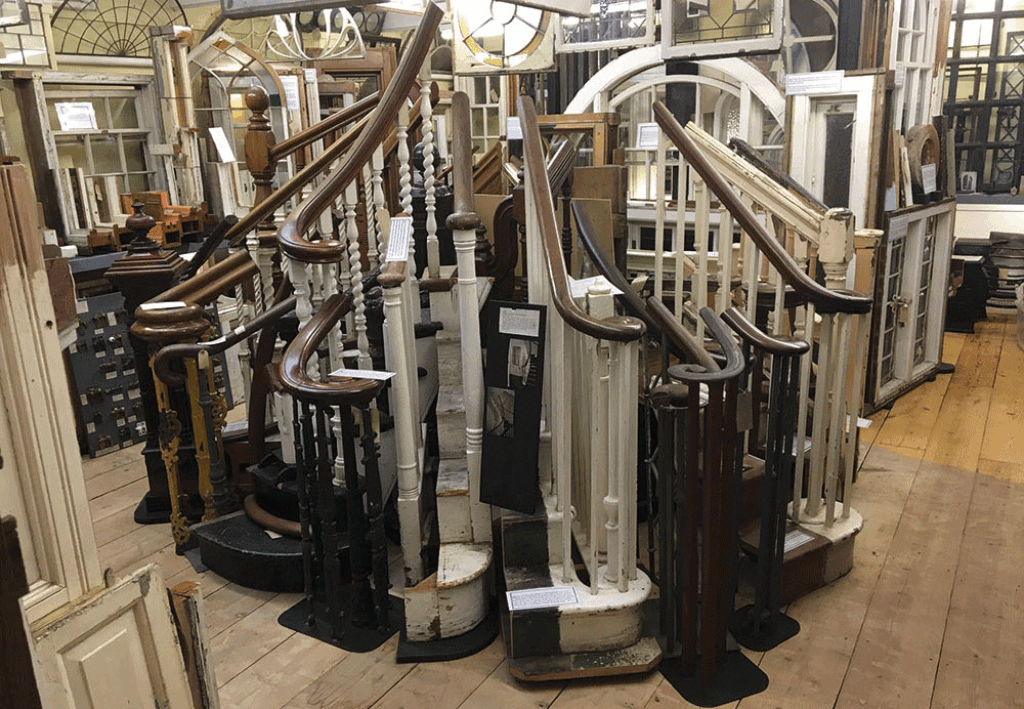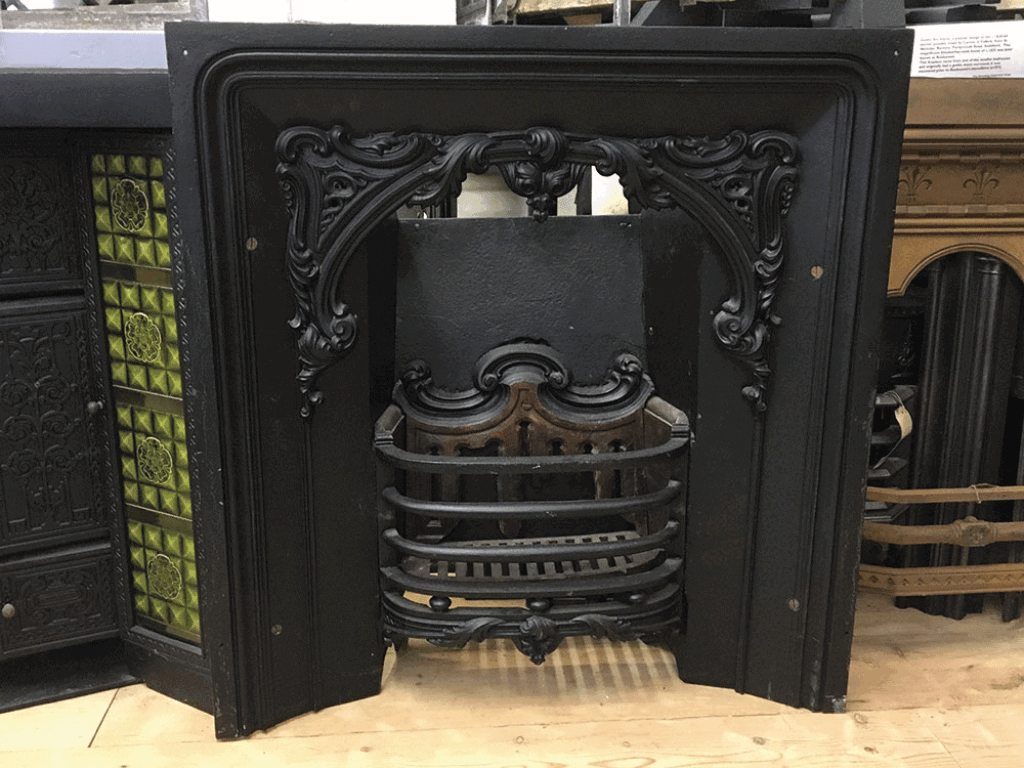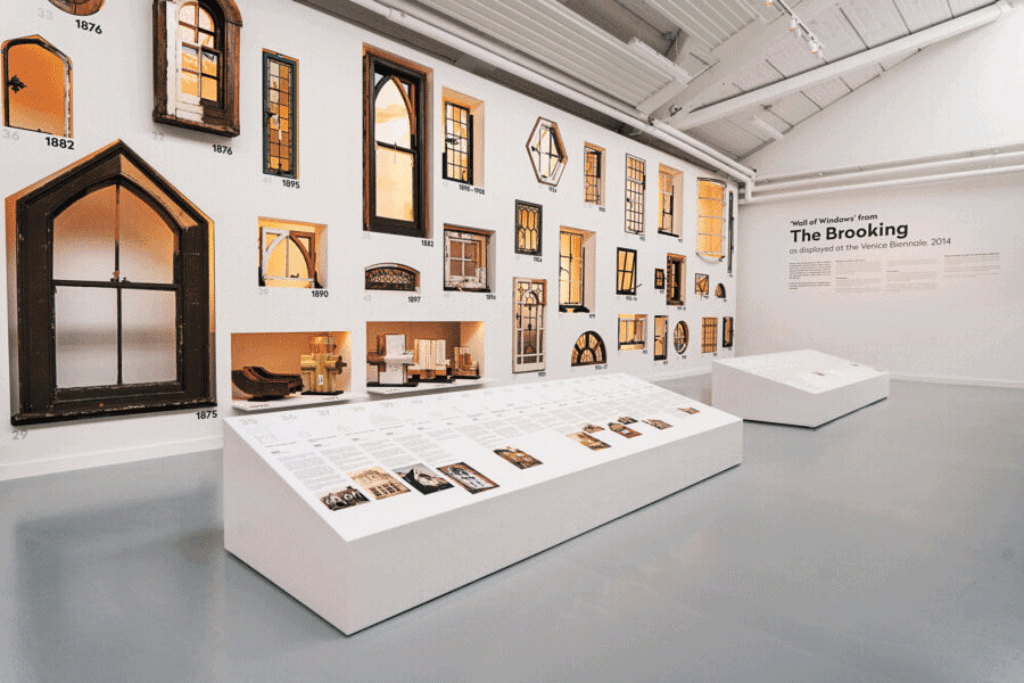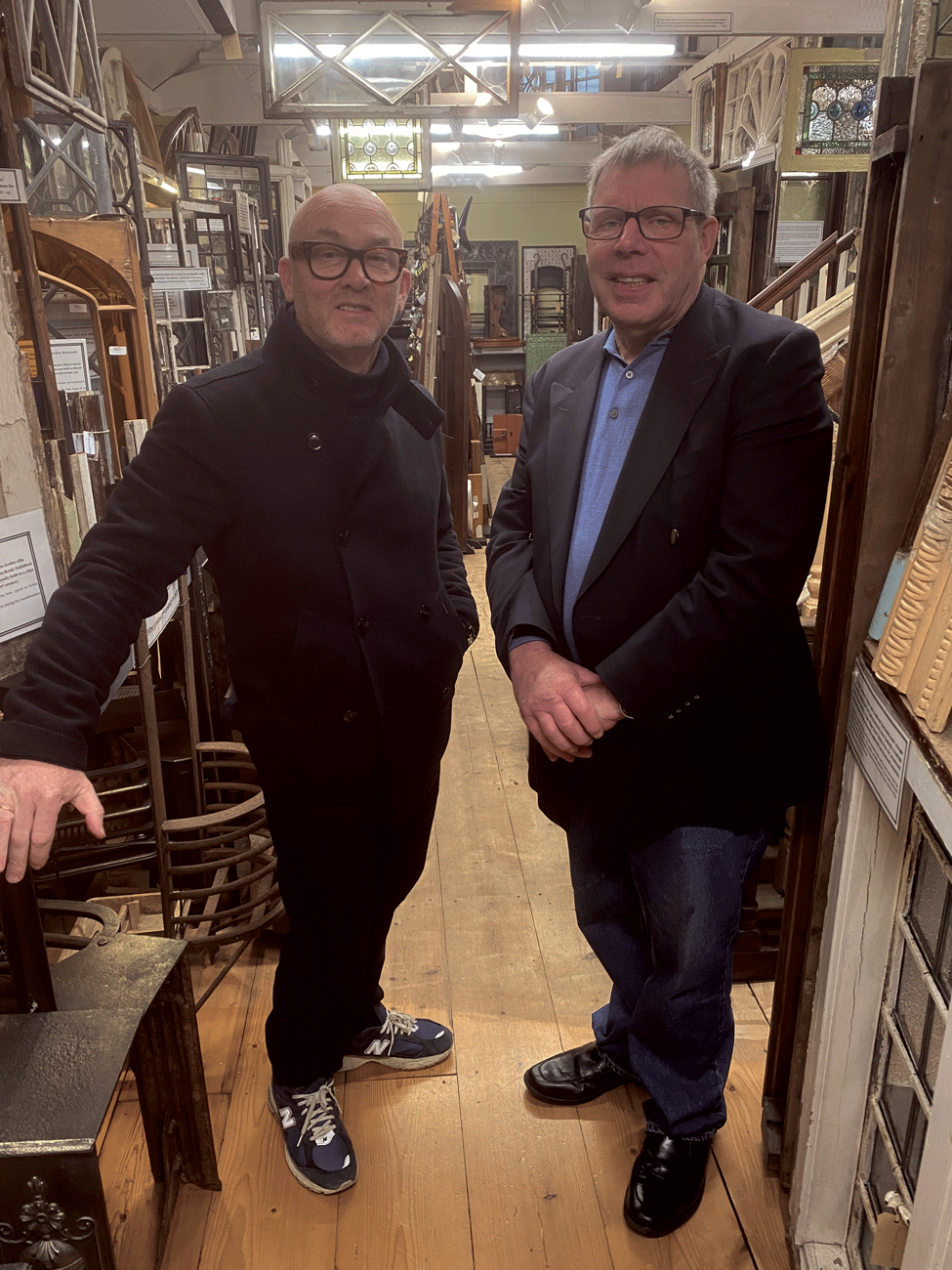
Charles Brooking, Architectural Historian and Consultant // Main Photo: Charles with Drew Pritchard in the teaching museum, Cranleigh
A few weeks ago, in October, we had Drew Pritchard here from the ‘Salvage Hunters’ series on Quest T.V. with his team from Curve Media filming me and the teaching gallery all day as part of a new series on the restoration of his new magnificent Georgian townhouse in St. James’s Square, Bath.
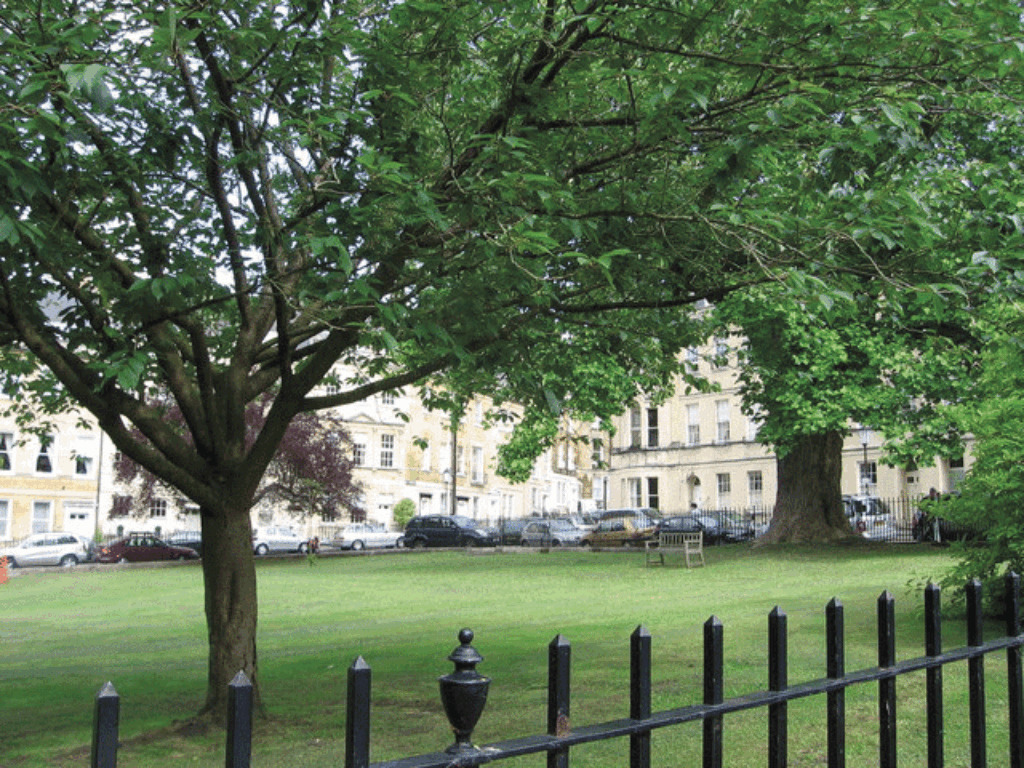
I first met Drew around 2005 when my partner, Susan, and I visited him at his stained glass studio in Conway, North Wales. This studio was based in a former non-conformist chapel nearby and it proved to be a fascinating visit. Drew kindly donated to the then Brooking Museum (now known as ‘The Brooking’) a large cross-section of domestic stained glass from houses in North Wales, dating from the 1900s to the early 1960s. The Victorian tradition of fitting decorative glass in porches, front doors, landing windows and transom lights, continued in North Wales up to the 1960s, the styles ranging from ‘Art Nouveau’ to ‘Art Deco’, with some ‘Arts & Crafts’ varieties being fitted throughout the 1920s-30s. This was an important addition to the Brooking Museum’s collection of stained glass. Drew told us to hunt through the basement store of the chapel where he held a large stock of smaller transom light windows he had ‘rescued’ from houses in the area when they had been replaced by double-glazing. All these stained glass panels were in their original wooden or steel frames and were in excellent condition.
We paid a second visit a few years later to Drew’s separate store, where he kindly donated 18th century panelled doors from historic Compton Verney house in Warwickshire. I also exchanged a religious stained glass window for a superb cast-iron staircase newel-post with a carved mahogany handrail.
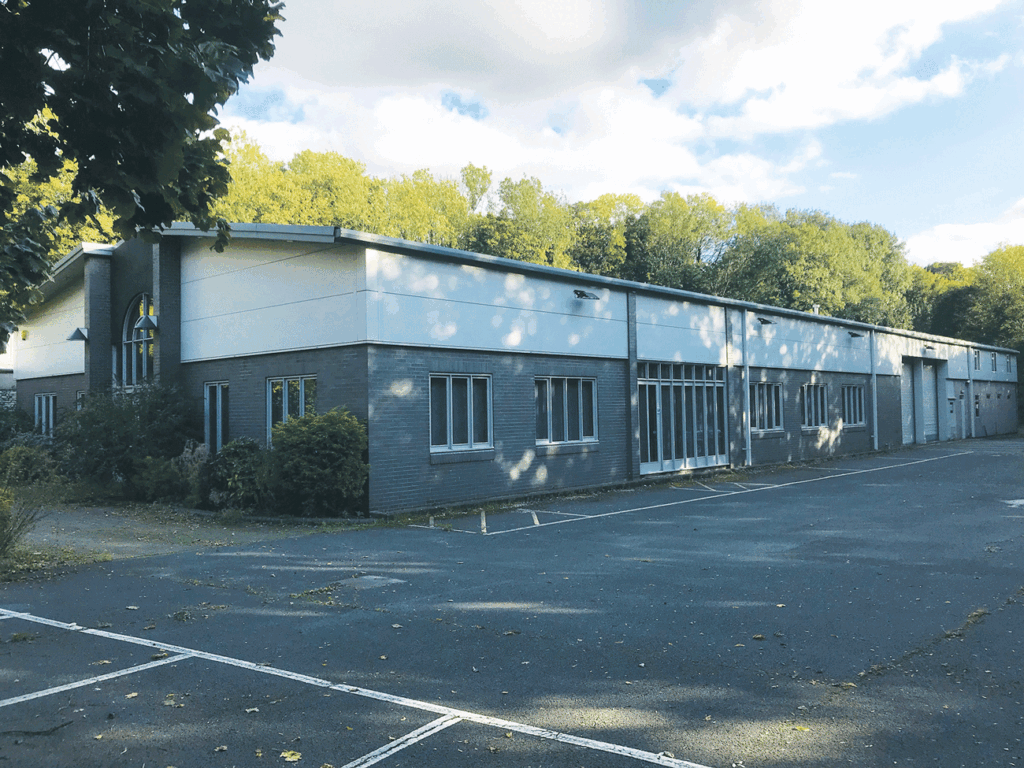
We have kept in touch since then and, of course, have closely followed his travels as an antiques dealer on Quest T.V. Drew was delighted to learn that ‘The Brooking’ museum charity has now secured a permanent home for the museum in Whitchurch, Hampshire.
Having recently purchased a fine Grade II listed 1790s terraced house in St. Jame’s Square, Bath, Drew recently contacted me to enquire whether ‘The Brooking’ museum’s ironmongery collection contained examples of 1790s door furniture. Fortunately we hold some important examples, ranging from humble to grander varieties. Drew, on learning this, arranged to visit The Charles Brooking Teaching Gallery here at Cranleigh with a film crew, whereby they would film us talking and inspecting period door and window fittings, along with the displays in the gallery. Having photographed the appropriate door handles and locks of the types used both in the ‘polite’ and secondary areas of Drew’s house in the 1790s, he is hoping to track down similar examples. I explained firmly that nothing was for sale and that the entire collection, including the part I am maintaining at Cranleigh, now belongs to ’The Brooking’ museum charity.
Drew has an engaging and enthusiastic personality and was keen to learn more about the future of the museum, and has asked if I can visit his townhouse in Bath to undertake a detailed analysis of the historic joinery details, including the doors, windows, staircase, architraves and skirting. The series on the restoration of his house will be screened in late 2024 to early 2025. This is going to be a major restoration project and Drew is determined to recreate the original late Georgian feel, the house having been converted to flats prior to his recent purchase of the property. This is one of many projects I have been involved with as an historic building consultant over the last year.
‘Meanwhile, ’The Brooking’ museum charity has appointed a new Chairman and 3 new Trustees, with more to follow, to lead the project forward. I am now employed as a consultant to the charity, to assist with the vital work of ‘knowledge-capture’ as part of their pilot scheme, and visit the Whitchurch site for this on a regular basis.
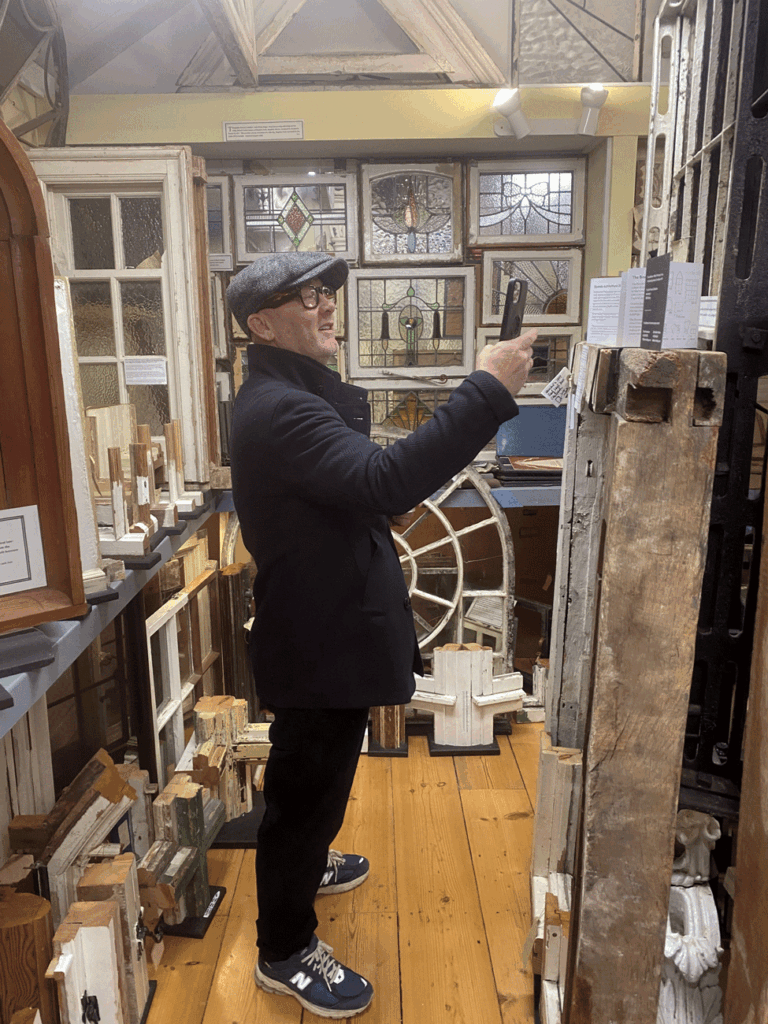
Although the majority of my time is now spent refining and cataloguing the collection, both at Cranleigh and Whitchurch, I am still endeavouring to fill gaps in the various collections and am continuing to visit buildings of importance. This summer I purchased an extremely rare iron and brass c. 1740s-50s ‘Doctor’s Pattern’ door-knocker at the Decorative Home & Antiques Fair held at the Loseley Estate near Guildford.
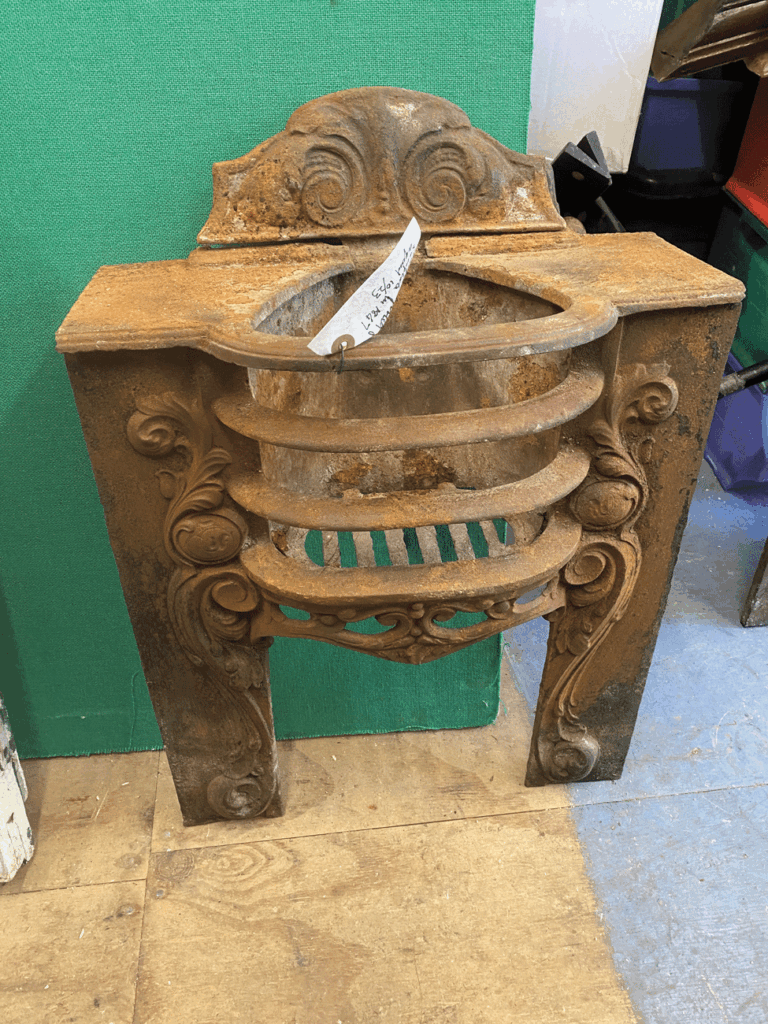
Local developer, Andrew Buchanan, kindly donated a fine early Victorian cast-iron hob-grate of an unusual design, and other items, from the former Robin Hood public house in Sydenham Road, Guildford, which has just been demolished, built in 1864. This grate is also interesting as the cast-iron sections are held together with split pins as opposed to having been bolted together.
I am shortly visiting the former New Scotland Yard building in London, designed by Richard Norman Shaw, c. 1890, to view windows and ironmongery that are being removed, to make a selection of relevant pieces.
We have also hosted group visits at the Cranleigh teaching gallery from Historic England, English Heritage, and from The Society for the Protection of Ancient Buildings (SPAB), among others.
This week we had a visit from the well-respected U.K. blacksmith, Chris Topp, and his wife, who were researching 17th and 18th century wrought-iron door and window furniture. I was able to show them a wide range of wrought-iron hinges dating from the late 17th century to the mid-19th, and some original shutter-hinges from the section designed by Sir Christopher Wren at Hampton Court Palace. They also examined wrought-iron windows in the display dating from the mid-16th century to the early 19th, one of these originating from a cottage in the Ewhurst Road, Cranleigh. Another detail they closely inspected was a section of an internal door, c. 1710-20, with its original wrought-iron thumb-latch, from The Greyhound public house, Lower High Street, Guildford. The principal purpose of the collection is to act as an educational and inspirational resource, assisting those in the care, repair and understanding of their properties, and as a formal teaching resource for those involved in the study and conservation of historic buildings of all types.

’The Brooking’ museum charity has just appointed a new Chairman and new Trustees who will lead the creation of the new museum.
Last year I was appointed as an Associate Brother at The Artworkers’ Guild in Queen’s Square, London, which will enable me to meet a wide range of people involved in the arts generally.
It has been an exciting year.
For more information contact:
Charles Brooking Architectural Historian and Consultant +44 (0)1483 274 203

